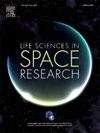The hypercapnic environment on the International Space Station (ISS): A potential contributing factor to ocular surface symptoms in astronauts
IF 2.8
3区 生物学
Q2 ASTRONOMY & ASTROPHYSICS
引用次数: 0
Abstract
With increasing advancements and efforts towards space exploration, there is a pressing need to understand the impacts of spaceflight on astronauts’ health. Astronauts have reported signs and symptoms of dry eye disease upon traveling to the International Space Station (ISS), thus necessitating an evaluation of the factors that contribute to the onset of spaceflight associated dry eye disease. Prior literature describes the hypercapnic environment of the ISS; however, the link between the high CO2 levels and astronauts’ symptoms of dry eye disease remains unexplored. Due to the terrestrial relationship between a hypertonic environment and ocular irritation as well as the terrestrial association between CO2 exposure and subsequent corneal acidosis, there is a strong necessity to investigate the relationship between the elevated CO2 levels in the closed environment of the ISS and astronauts’ risk for dry eye disease development.
国际空间站(ISS)的高碳酸环境:宇航员眼表症状的潜在影响因素。
随着太空探索的不断进步和努力,迫切需要了解太空飞行对宇航员健康的影响。宇航员在前往国际空间站(ISS)时报告了干眼病的体征和症状,因此有必要对导致与航天有关的干眼病发病的因素进行评估。先前的文献描述了国际空间站的高碳酸环境;然而,高二氧化碳水平与宇航员干眼症症状之间的联系仍未被探索。由于高渗环境与眼部刺激之间的陆地关系以及CO2暴露与随后的角膜酸中毒之间的陆地关系,因此非常有必要研究国际空间站封闭环境中CO2水平升高与宇航员干眼症发展风险之间的关系。
本文章由计算机程序翻译,如有差异,请以英文原文为准。
求助全文
约1分钟内获得全文
求助全文
来源期刊

Life Sciences in Space Research
Agricultural and Biological Sciences-Agricultural and Biological Sciences (miscellaneous)
CiteScore
5.30
自引率
8.00%
发文量
69
期刊介绍:
Life Sciences in Space Research publishes high quality original research and review articles in areas previously covered by the Life Sciences section of COSPAR''s other society journal Advances in Space Research.
Life Sciences in Space Research features an editorial team of top scientists in the space radiation field and guarantees a fast turnaround time from submission to editorial decision.
 求助内容:
求助内容: 应助结果提醒方式:
应助结果提醒方式:


